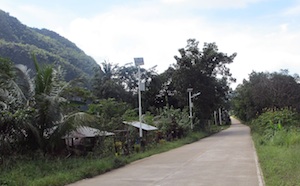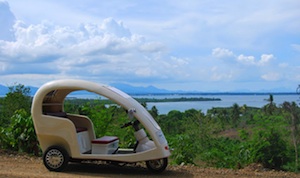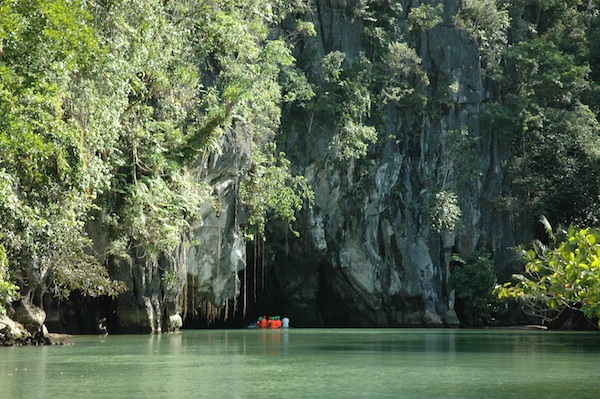Towards a Model City in Sustainable Development
The Palawan Biosphere Reserve is a cluster of islands composed of one long main island and smaller groups of islands around it. O 1,150,800 hectares of the biosphere reserve include the entire Province of Palawan Island, which is the westernmost province of the Philippines.
Puerto Princesa, capital of the Palawan province, is also known worldwide thanks to the underground river flowing close by, where the Puerto-Princesa Subterranean River National Park was created. The park was included in UNESCO’s World Heritage List in 1999.
Puerto Princesa é uma cidade multiawarded e pioneiro em iniciativas ambientais nas Filipinas. ‘The City in a Forest’ is the designation that embraces the sustainable city strategy.
Solar and hydro power for a sustainable city
Em Junho 2010 the City of Puerto Princesa formed a technical partnership with Optimal Power Solutions (OPS) in order to address the city’s power shortage, atualmente estimado em 5 para 10 MW.
Um problema contínuo e significativo tem sido o fornecimento de energia sustentável para Puerto Princesa. Presentemente, grupos geradores movidos a diesel fornecem uma capacidade de 30 MW de energia para os habitantes de Puerto Princesa. OPS e do plano Câmara Municipal para projetar e implementar fontes de energia renováveis para gerar fonte de alimentação adicional, reduzir o consumo de combustível diesel e promover um futuro de energia sustentável e viável. Prevê-se que novas fontes renováveis de até 10 MW serão integrados ao longo fases sucessivas. Esta capacidade renovável vai priorizar a exportação de energia fotovoltaica na rede para melhor suporte e menor uso dos atuais geradores a diesel. A primeira fase do 1 MW progredindo até 2MW, 5MW e finalmente 10 MW prevê crescimento de carga futuro da Cidade.
Além disso, the Palawan Electric Cooperative (PALECO), the City Government of Puerto Princesa and WEnergy Global PteLtd have signed a Memorandum of Understanding (MoU) for the development of a hybrid electric power plant (1.5 MWp) to cover electricity supply of the Baranguy Cabayugan.
Hydro power is also part of the city’s energy strategy. As gêmeas 3.4MW hidro-turbinas fornecer pelo menos 32 million kWh of electricity to the Palawan grid. Hydropower will replace the old and expensive to run NPC generators.
Mais casas energeticamente eficientes
A crescente população urbana de Puerto Princesa levou ao congestionamento na área da baía da cidade, ameaçando a qualidade de vida das pessoas e áreas de reserva costeiras. Projetos habitacionais na costa em Puerto Princesa City foram projetados para reduzir a demanda de energia através do aumento da luz natural, melhor ventilação, o efeito de resfriamento do material de cobertura e plantio estrategicamente pelo menos uma árvore de fruto por família.
Os potenciais poupanças anuais de carbono é estimada em pelo menos 72 toneladas para a 330 famílias. Outras características verdes dos projetos habitacionais incluem a instalação de uma unidade de captação de água da chuva, que reduz a demanda de bombeamento de água, proibição do uso de madeira para o teto e quadros de interiores e um sistema de destinação adequada para os não-recicláveis e não-biodegradáveis.
Greening transportes públicos
The local government of Puerto Princesa has entered a partnership with the Institute for Climate and Sustainable Cities (ICSC), a non-governmental organization based in the Philippines working on “sustainable energy solutions and fair climate policy.” This partnership is under the Climate-Friendly Cities initiative of the iCSC, an initiative which combines waste management, geração de energia renovável e programas de transporte sustentável para o desenvolvimento sustentável, climate-resilient city and community development.
Atualmente, Puerto Princesa tem jeepneys elétricos (e-jeepneys) in the local government fleet and for private use, as well as electric tricycles (e-trikes), que são improvisado veículos de três rodas de motocicletas. O conceito de e-jeepneys foi desenvolvido pelo ICSC através de um financiamento pelo holandês fundação, DOEN. E-jeepneys foram introduzidos em Puerto Princesa em 2009, com a cooperação política desempenhando um papel importante na institucionalização dos veículos elétricos como o transporte público. The power requirements of the electric feedjeeps and tricycles will be partly covered by the Waste-To-Energy project, jointly developed with the Institute of Climate and Sustainable Cities.
Reducing tourism’s carbon footprint
Puerto Princesa is currently among the top 10 major tourist destinations in the Philippines, and is striving to be the country’s number one tourist destination for eco-tourism.
Puerto Princesa has extended the concept of energy sustainability to the tourism sector, one example being its participation in the SWITCH-Asia ‘Zero Carbon Resorts’ project that seeks to enable tourism SMEs, tais como hotéis e resorts, para prestar os seus serviços de energia de uma forma eficiente, rentável, e ambientalmente forma de som.
O projeto aplica a estratégia 3R: Reduza-Substitua-Redesenho. O primeiro passo é o de reduzir o consumo de energia em hotéis e estâncias, eo segundo passo é substituir os dispositivos baseados em fósseis ineficientes com melhor, tecnologias verdes. Na fase Redesign, a showcase ‘Zero Carbon Cottage’ will be built in Palawan, que vai operar usando energia solar- e sistemas de geração de energia de biomassa.
Canada
Consistent with the vision of an environmentally sustainable city, Puerto Princesa will take a lead role in promoting environmental stewardship building mutual support and cooperation with cities in the Asia-Pacific region.
The ‘City in the Forest’ becomes the stage for the future of energy supply in The Philippines by enabling the mix in energy to contribute to stable prices for consumers and the mitigation of global warming.


















